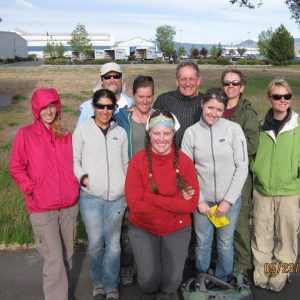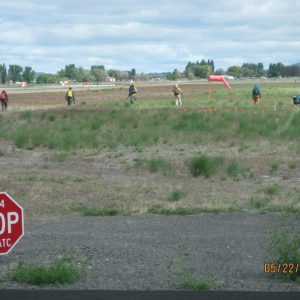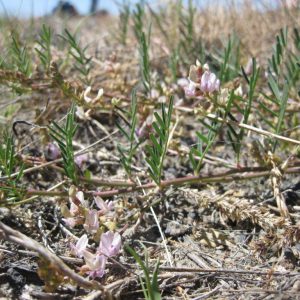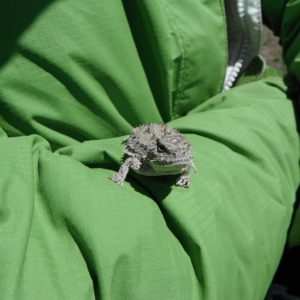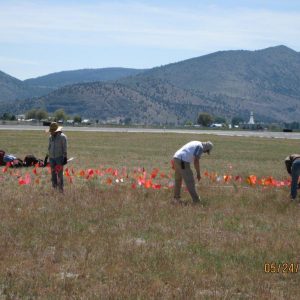So far we’ve been carrying out our usual outings into the desert trying to find certain key areas that had not been checked on in decades. However, the new fun thing I was able to experience for the first time was to ride in a UTV! I even drove it down some bendy roads so I did not even mind my eyes watering and my hair blowing like crazy in the wind. I was also able to build MIM frames today for one of our office’s wildlife biologists and even signed on to create a device to attach to the sitting water tanks that would allow for an efficient drip irrigation system. I’m looking forward to completing these projects but, in the meantime, am completely excited to meet all the other interns and gaining some new knowledge at the workshop! See you guys soon!
Daily Archives: 12 June, 2013
Spring is in bloom!
The Bishop field office for the BLM covers a lot of ground, from Owens Lake in the South all the way to the Nevada border near Bridgeport. Three-quarters of a million acres of habitats ranging from true desert to sagebrush steppe, alkali flats, wetlands and windswept mountains. While tracking down sage grouse nests and populations of seed-bearing plants I’ve come to appreciate all that our region has to offer, but my favorite habitat at the moment has to be low-sage scrub. Artemisia arbuscula is not a particularly showy plant, its grey-green limbs barely rising above the baked clay soils it prefers. Male sage-grouse prefer it for their leks, since females can watch them prance about unobstructed. The reason I like low sagebrush however, is that our small islands of A. arbuscula seem to contain the vast majority of flowers in our field office. Even in this especially dry year, hardy perennials like Biterroot and Crepis species are turning the barren expanses of clay bright shades of yellow and magenta with their blossoms. Coincidentally, these are some of the same species that I need to collect seed from, so I get to soak in the display as I look for mature seedheads.
On that note, 10,000 seeds is a lot of seeds! I recently finished my first collection, the not-as-showy but still lovable Lomatium nevadense. Even with 20-100 seeds per plant, it still took a lot of searching with my head down to pick enough for a collection. Worth it though, since according to our wildlife biologist L. nevadense is a favorite snack for the sage grouse. I know that if I spent my mornings jumping to and fro with huge yellow sacks on my chest, I would want a snack as well so I’m glad that we now have this seed to potentially use for revegetation efforts.
Busy bear
It has been busy since I arrived and the time is flying by. My days have been filled with trainings in pollination and range indicators, HAF transects, weed management, willow planting, seed collecting, and more. Just when I thought it couldn’t get better, we went camping. When we travel long distances we camp to save driving time. I have always enjoyed camping and it makes learning and doing my job that much better. During one of our long commutes we spotted a bear. I am new to Nevada as well as the desert. When I think of these two things, bears do not come to mind. It was a treat to get to see this black bear on our way to HAF transects.
It’s a Bird It’s a Plane…No It’s Really a Plane.
The past few weeks have been filled with lots of new adventures, surveys, and sights. One week was spent surveying for Applegate’s milkvetch, an endangered plant species endemic to the Klamath Basin. It just so happens that the largest population of Applegate’s milkvetch is located at the local Klamath Falls airport. Therefore, to survey for this species we had to have a 3 hour information and safety discussion on the airport and airplanes. We then had to be escorted to patches of grass in between the taxi ways and runways by airport crew members to survey for this plant species while planes and U.S. airforce jets were frequently taking off. Needless to say, it was a pretty crazy environment with planes and jets taking off here and there, in such close proximity to us. It was also pretty amusing to try to coordinate and communicate with a crew of about 7 people while all wearing earplugs to protect our ears from the loud jets. Thus far, it was definitely the most bizarre environment I have worked in doing plant or wildlife surveys. To add to the craziness, it was also a very bad weather week with some rain, snow, sleet, hail & strong winds- which does not help at all when you are basically in the most exposed area you can be. Surveying for Applegate’s milkvetch at the airport may not have been my favorite field time this season, but looking back on it now only a couple of weeks after, I am glad to have had the experience and some very comical memories to accompany it.
The past couple of weeks I have been surveying for lost river, modoc, and shortnose suckers, as well as monitoring bald eagle nests around the Basin. We first set up four fyke nets for a week to try and catch some juvenile suckers in a pond, where they had been imported, but we failed to catch any live suckers. The biologist lead of the suckers thinks that it had been a cold winter and that the pond had suffered a hard freeze, consequently wiping out the small sucker population in the small pond area.
Yesterday, one of my coworkers and I traveled to a forest stream in northern California to electroshock to try and find Modoc suckers. Unfortunately, we did not discover any suckers in the stream portion that we electroshocked but we did catch many brown trout, speckled dace, and pit river sculpin. Brown trout are very invasive to this area and are impeding conservation efforts of native fish, so unfortunately we had to practice eradication on the brown trout that we caught. On the bright side though, we will be making some delicious fish tacos now!
Other than fish and plants, my time has been spent checking up on eagle nests that were established earlier this season to monitor them and see how many young (if any) they have. It has been exciting for me to see nestling eagles for the first time! The ones that I have seen this week have been very big baby birds with dark feathers, bright orange beaks and large curious eyes. They seem to be beginning to get a little bit antsy in their nests and in the next few weeks should begin to really stretch out their wings and fledge!
Here are some photos from the milkvetch airport surveying.
Range
My time at the Carson City BLM office has illuminated a novel type of land use that I have not experienced in other places that I’ve lived- Range. This traditionally significant practice still plays a large role within the BLM, often overshadowing other endeavors and projects, and we find ourselves continually pushed onto one rangeland assessment after the other. We recently attended a Rangeland Health conference in Reno, NV, which was a truly enlightening experience, providing considerable insight into how a great portion of western lands are currently managed. The practice of Rangeland Health first gained popularity in the 1970s, when most of the primary evaluations of grazing allotments were made. This qualitative assessment tool paints a broad picture of the landscape of interest, cataloging a variety of indicators at the site such as erosion, invasive species composition, decadence, and soil compaction. This initial inventory is known as the reference state, which is the basis of all comparisons for future assessments and the purported true state of that ecosystem. This is after a century’s worth of grazing, of course. Further evaluations of rangeland health are made in reference to this first documented assessment, and the quality of the landscape is summarized into how far it departs from this reference state. For example, an allotment that is historically 85% Bromus tectorum and has high levels of soil erosion is found 20 years later to hold similar characteristics, the health assessment is labeled as a “None to slight departure from reference”, and range practices such as cattle grazing are permitted to continue. I find it endlessly intriguing to see such remnants of archaic ecological principles still in high use as a primary tool for evaluating the health of our western landscapes.
Vernal venture
I wrote before about monitoring for endangered, sensitive and threatened plants. We have started to work more with the Seeds of Success program to identify potential populations for seed collection. What a great way to learn the flora of an area… to do seeds of success! We are in the field every day looking for large populations of native plants. We have a list of priority species, and when we identify populations we start by taking herbarium vouchers and assessing the seed potential seed production of the site.
We have identified 11 potential populations, and think many will be ready for collection when we get back from Chicago!
Through the first four weeks of this internship I have been constantly comparing this summer to my past summer as a CLM intern. A little background: last summer I lived in Cedarville, CA at the Surprise Field Office (The name comes from the Surprise Valley, where Cedarville, resides). Cedarville is an amazing place, unlike anywhere I’ve ever been before. Coming from the Northeast, it was quite a transition. There are about 550 people in Cedarville, and less than a thousand in the whole valley. The closest town of any significance is Alturas (~2,500 pop.). Other than that it was Reno, Redding, or Klamath Falls, which were about 3 hours away. Needless to say, the area was isolated. This was both a challenge and a reward. The Surprise Valley really is the western experience, and if you like recreating outdoors, it was a great place as well. Botanically, the area was very challenging for me to get used to. Where were the trees?!? However, despite these challenges, I learned a lot about myself, living in a small ranching town, and the land management field.
Coming back for a second year has so far proved to be a great decision. Not only have I been able to contribute to my new field office in a way like never before (because of my past CLM internship), but I am also constantly becoming exposed to new land management challenges that were virtually nonexistent in the Surprise Field Office. A major focus for this office is oil and gas leasing, specifically coal bed natural gas. Because of this, the office is much bigger than I am used to (2-3 times bigger). It also means there is a whole host of associated environmental impacts. Although I probably won’t be directly involved with this part of the field office, I am trying to learn from others in the field office of the impacts of coal bed natural gas and its mitigation efforts. Fossil fuels and fracking are both “hot words” in today’s media, and I hope to educate myself on the issues and educate others with this firsthand experience.
Another issue which I wasn’t exposed to last year was the fragmented ownership of the area. Surprise Field Office, although located in California, has most of its resource area in Nevada. Nevada’s land area is 67% BLM, and the Surprise resource area was mostly BLM. Here surface ownership is mostly private and in many cases BLM is a minority land owner. Therefore, many times we have to call landowners many days in advance to obtain permission to cross their land. This adds an extra element of planning into our work.
Botanically, there are many of the same species. Others from the West may say the areas are very different; however, coming from the East, these two areas look very similar compared to where I grew up. It has been nice to build on this botanical knowledge. Where last year I was overwhelmed by the amount of new species, this year I am able to take my time learning new species and identify ones I already know.
Buffalo and the surrounding area are gorgeous. The Bighorn Mountains to the West look like an excellent playground, and the rolling hills of the basin are truly spectacular. Although many say Buffalo is a small town (~4,500), it looks like New York City compared to Cedarville, and there always seems like there’s something to do. I’m very lucky to be in a great place with a job I love!
Into the West
The past couple of weeks have been intense. I was offered my internship a week before graduating from the University of Kansas, so I had a week for finals, a week for packing, and then I headed straight for my new home: Buffalo, Wyoming! I have found out that living in Kansas is about as far west as you can get in America without actually being in “the West”, as the feel of frontier days still permeates the countryside. Things move slower here, people talk more, and Mother Nature is indomitable. Buffalo is situated at the base of the Bighorn Mountains, which is part of the Rocky Mountains. The scenery is beautiful, and almost every day in the field is picturesque. The people I have encountered here are very welcoming and friendly, making the transition much easier. My fellow interns are awesome, and the staff at the BLM in Buffalo are more helpful and understanding than I could have ever hoped for. I am being trained primarily in range management, which involves evaluating land leased out by the BLM for species composition and overall ecological health and productivity. The work is very involved, and I feel like I have learned more in the past ten days than I learned in entire semesters of college! Anyway, I have taken quite a fancy to my job and where I work, and I wish it would never end!
Beginnings in Bountiful and Beautiful Buffalo, WY!
This place is gorgeous!
Some might say it’s small and a bore. All that means is there’s more to explore. So spend your money on great food and gas, and keep driving that motor home right on past. (Working on my hokey rhymes!)
Driving from good ol’ Tennessee, I thought I’d be lonesome in the expansive fields of crops our nation’s farmers tend. Experience is quite the opposite! Blaring whatever my car’s AM/FM radio would pick up (rock, pop, country, and NPR), I toted my belongings right along. Most of my trip’s action was surprisingly in South Dakota where I saw the world’s only corn palace, the highly advertised Wall Drug, and Badlands National Park with all its beauty and wildlife. All this to crest over a Wyoming town and see the ice-capped skyline of the Bighorns. This was my first driving view of the western mountains, and man, did I feel small?
I’ve been here for 2 weeks now, and making my way in Buffalo has been a smooth transition. My mentor, the other interns, the entire BLM staff, some NFS staff, and other locals have been more than friendly. Smiles and “good mornings” make it sound cheesy, but try staying grumpy when your time off has so much potential between the active townspeople and the Bighorn mountains (maybe 5 miles away).
The first week was filled with documentation, government approval, and a quick outing. The second week, however, we’ve really hit the field as Range interns . Being in a new environment, I feel I’m relearning some of my plant identification. TN’s got its trees and mosses, and WY’s got its grasses and sagebrush. Spending time training in the field has exposed me to a new ecosystem, one in which cattle and sheep have been utilized as factors for land use and preservation. In running through protocols, we’ve begun to develop an understanding of what our role, through BLM, is in monitoring and managing land use.
Soon, myself and fellow interns will be cut loose to conduct our work. Looking forward to a great internship in Buffalo, WY!
Moving right along!
It seems so much has happened in the last month that it’s hard to know where to even start. My colleague and I concluded our Bradshaw’s lomatium monitoring just in time to attend the Willamette Resources & Educational Network’s (WREN) annual Walkin’ and Rollin’ Through the Wetlands event. WREN is a partner organization of BLM’s in the Rivers to Ridges Partnership, which works to protect and enhance the land and water resources in the upper Willamette Valley. WREN, as its name implies, is dedicated to providing environmental education to the public.
My colleague and I both helped man BLM’s West Eugene Wetlands booth, there to educate the community on BLM’s involvement in restoring the wetlands. Unfortunately, not many community members attended the event this year (last year we had upwards of 90 people and this year maybe 20); Eugene was still in the middle of its unusually hot and sunny weather at the time, which could have kept people indoors. Luckily, our booth was right next to the Oregon Department of Fish & Wildlife’s booth, which meant that I was fortunate enough to see various pelts of animals found in the West Eugene Wetlands area, from beaver to mountain lion and bobcat pelts. I also learned a few things. For example, did anyone know that gray foxes–the red fox’s smaller, less seen cousin–can climb trees? I sure didn’t.
This year field season is moving impossibly fast. We’ve just finished both the Fender’s Blue Butterfly and Kincaid’s lupine monitoring. Before starting the lupine monitoring, it was important that the burtterfly monitoring be finished; the Kincaid’s lupine is the host plant for the Fender’s Blue Butterfly, and so any premature handling of the plants would stir up and disturb the butterflies.
Up next on the agenda is Willamette Daisy (Erigeron decumbens var. decumbens) monitoring, which is my favorite of the plant species we monitor!
‘Til next time!



